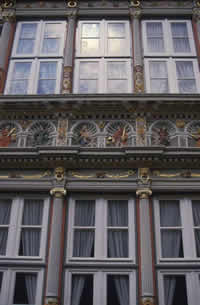
![]()
Window Fundamentals
![]() Fenestrations are glazed apertures in buildings. These include conventional
windows, roof skylights, glassed doors, clerestories, roof monitors,
a variety of tubular daylighting devices (tubular skylights), and sloped
glazings of different kinds. Fenestrations are normally placed in buildings
to provide a view of the outdoors and for the admission of daylight
illumination to the interior. Along with these generally desirable
features come solar radiant heat gain (generally desirable in winter
and undesirable in summer) and conductive heat transfer. The latter
adds to the cost of heating the building in winter and cooling it in summer.
The daylight illumination, while generally desirable, can also be a source
of unwanted glare. The solar heat gain accompanying it can induce occupant
discomfort as well as increased air conditioning costs.
Fenestrations are glazed apertures in buildings. These include conventional
windows, roof skylights, glassed doors, clerestories, roof monitors,
a variety of tubular daylighting devices (tubular skylights), and sloped
glazings of different kinds. Fenestrations are normally placed in buildings
to provide a view of the outdoors and for the admission of daylight
illumination to the interior. Along with these generally desirable
features come solar radiant heat gain (generally desirable in winter
and undesirable in summer) and conductive heat transfer. The latter
adds to the cost of heating the building in winter and cooling it in summer.
The daylight illumination, while generally desirable, can also be a source
of unwanted glare. The solar heat gain accompanying it can induce occupant
discomfort as well as increased air conditioning costs.
- Click Here for a Glare Tutorial
 Designing, orienting, shading, and sizing windows to increase their benefits
while reducing problems (glare, overheating, condensation, cold draft, large
heating or cooling loads, furniture fading...) is an important goal of the
building designer. Click here for information on UV
Transmittance & Fading.
Designing, orienting, shading, and sizing windows to increase their benefits
while reducing problems (glare, overheating, condensation, cold draft, large
heating or cooling loads, furniture fading...) is an important goal of the
building designer. Click here for information on UV
Transmittance & Fading.
If the original design is not good in these areas, occupants may experience problems. Best results are achieved when the building is designed from the beginning for good use of fenestrations, avoiding the problems while maximizing the benefits.
- Click Here to see the Windows Terminology Glossary
Replacing old, poorly performing fenestrations with improved windows, shades, or other attributes can be somewhat expensive. However, replacing old windows with well-chosen energy-efficient ones can result in significant yearly energy savings, better comfort, and improved occupant satisfaction. While desirable in residential buildings, these improvements can also increase worker comfort, job satisfaction, and productivity in commercial or office buildings. Often the productivity enhancements save more dollars than the entire energy bill itself!
Energy and Comfort
 There are important human factors and energy aspects to window design, placement,
and sizing. In the past, when the variety of available window designs was
limited in a given climatic region, the selection of an appropriate window
design was a relatively easy task. Now, however, due to the greater variety
of technological and other options, finding the best window for your situation
can be a little difficult.
There are important human factors and energy aspects to window design, placement,
and sizing. In the past, when the variety of available window designs was
limited in a given climatic region, the selection of an appropriate window
design was a relatively easy task. Now, however, due to the greater variety
of technological and other options, finding the best window for your situation
can be a little difficult.
The portions of this web site dealing with windows in residential buildings have been designed to assist the homeowner in making the right choice. The master menu in the blue bar to the left is your starting point for accessing a wide variety of information provided here. Choose Residential Options if you wish to find out more about selecting the best window options for your residence.
In Florida, and other hot climates in the U.S., as well as regions with mixed climates that also experience hot summers, solar heat gain prevention is a very important part of good window performance.
- Click Here for more information About Solar Gain
Energy costs have risen dramatically in the last two decades. Window manufacturers have responded with increasingly better windows. The variety of windows available on the market today is large, making selection of appropriate windows for both residences and non-residential buildings a more difficult task.
Research is being conducted at the Florida Solar Energy Center to help designers select and design better fenestration solutions, to help window manufacturers design and manufacture better products, and to promote improved energy and comfort standards for fenestration systems of all kinds, including those with shades and other aperture controls. For more information see Fenestration's Research.
